|
| |
|
|
| |
|
|
| |
|
|
| Model: £gPAC-7186PEX-MTCP |
Model: £gPAC-7186PEXD-MTCP |
|
|
|
|
|
|
|
|
| |
|
|
| |
|
|
| |
The uPAC-7186PEX(D)-MTCP series features true IEEE 802.3af-compliant (classification, Class 1) Power over Ethernet (PoE) using a standard category 5 Ethernet cable to receive power from a PoE switch like the NS-205PSE. The uPAC-7186PEX(D)-MTCP also works as a Modbus/TCP to Modbus/RTU or Modbus/ASCII gateway that supports most SCADA/HMI communications based on the Modbus communication protocol.
ICP DAS provides easy-to-use software development tool kits (Xserver, VxComm, Modbus libraries). Users can use them to easily integrate serial devices to have Ethernet/Internet communication ability and through the standard Modbus protocol to communicate with SCADA software (Indusoft, ISaGARF, DasyLab, Trace Mode, Citect, iFix, etc.).
For the hardware, it also supports an I/O expansion bus. The I/O expansion bus can be used to implement various I/O functions such as D/I, D/O, A/D, D/A, Timer/Counter, UART, flash memory, battery backup SRAM, AsicKey and other I/O functions. Nearly all kinds of I/O functions can be implemented by this bus but the bus can support only one Xboard. There are more than 30 boards available for uPAC-7186PEX(D)-MTCP, user can use one suitable Xboard to expand hardware features. |
|
|
| |
|
|
|
|
|
| |
|
|
| |
|
|
| |
| Features of default Modbus firmware |
When you buy an £gPAC-7186PEX-MTCP controller, it already has the default Modbus firmware installed in Flash memory. The default firmware has the follows features:
- Converters single Modbus/TCP to multi Modbus/RTU
The £gPAC-7186PEX-MTCP is a Modbus/TCP gateway. It can easily upgrade many Modbus/RTU devices to have Ethernet communication ability.
-
Supports VxComm technique for every COM port of controllers
If serial devices don't support Modbus/RTU, you can still access these devices. But need to install VxComm driver on host PCs and assign a COM port number to link to the remote COM port (of £gPAC-7186PEX-MTCP). After that, serial clients can access these remote serial devices via standard RS-232 functions.
-
- Firmware modifiable
We provide the Modbus SDK allowing users to develop their custom Modbus firmware.
|
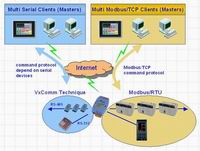 |
|
|
| |
| Modbus SDK ( in C language ) |
If the default firmware doesn't totally suit your requirement. You can use Modbus SDK to modify the default firmware to add extra functions. The Modbus SDK has below features: |
 |
-
Supports extra user-defined command protocol (TCP/IP)
Modbus/TCP protocol supports 2 basic data format (bit and 2-byte integer). It means if clients (or called masters) don't support Modbus/TCP or you need other format data (for example: string of floating value), £gPAC-7186PEX (with default firmware) cannot communicate with them. Using this feature, you can develop your special command protocol to transfer any format of data.
-
Register based programming method (easy to use)
Modbus library supports 4 internal register tables (iMemory_AI, iMemory_AO, iMemory_DI, iMemory_DO), you can use these to store specific information. When Modbus/TCP clients request to £gPAC-7186PEX-MTCP, Modbus kernel will response information from these 4 tables.
- Provides user-defined registers
The 4 internal register tables are all open to users. You need to assign these tables by yourself.
- Can Iink to Modbus/TCP slave devices
By using function ModbusTCP_Master2Slave(declared in MBTCP_7E.h),the £gPAC-7186PEX-MTCP can link 8 max . Modbus/TCP device.
-
Can link to Modbus/RTU slave devices
By using function ModbusMaster2Slave (declared in MBTCP_7E.h), Modbus/RTU devices can be easily integrated to internal registers of £gPAC-7186PEX-MTCP. An £gPAC-7186PEX-MTCP polling every Modbus/RTU devices and put every necessary information to internal registers. Clients only ask the £gPAC-7186PEX-MTCP to get all information of Modbus/RTU devices. That reduces loading of Clients.
-
Can link to non-Modbus/RTU serial devices
Some serial devices don't support Modbus/RTU. We provide functions to let £gPAC-7186PEX-MTCP access serial devices. You can put information to internal registers of it. Thus, the non-Modbus serial devices can also support Modbus/TCP.
-
Supports X boards
You can choose one suitable Xboard to add on an £gPAC-7186PEX-MTCP to be on board I/Os.
-
Xserver SDK compatible
Modbus SDK is based on Xserver SDK. To lear more programming skills, you can refer demos of Xserver. To get information of demos of Xserver, please refer to CD:\Napdso\7186e\TCP\Xserver\Xserver.htm
|
|
|
| |
| Modbus Utility |
We provide Modbus tools for Windows 98/SE/NT/2K/XP, it includes:
- Modbus Utility
- On-line configuration via Ethernet
- On-line help
- Automatically generate register mapping tables
- Configuration export/imp
- MBRTU
Modbus/RTU client (with source code in VB6) to diagnostic Modbus/RTU slave devices.
- MBTCP
Modbus/TCP client (with source code in VB6) to diagnostic Modbus/TCP slave devices.
|
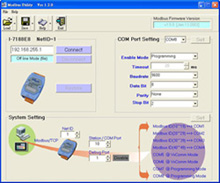 |
|
|
|
| |
|
|
|
|
|
| |
|
|
| |
|
|
| |
- Basic application 1: protocol converter
An £gPAC-7186PEX-MTCP runs a default firmware to become a single Modbus/TCP to multi-Modbus/RTU converter. You can simply use the Modbus Utility to configure the device and then set connection between SCADA, HMI software and the £gPAC-7186PEX.
|
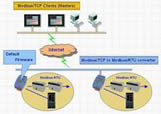 |
- Basic application 2: protocol converter with VxComm technique
An £gPAC-7186PEX-MTCP is also be able to link to serial devices that don't support Modbus/RTU. To use this function, you will need to install VxComm driver on host PCs. After installation, you will be able to access the remote COM ports via the standard serial driver.
|
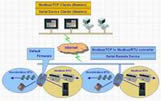 |
- Advanced application 1: Modbus/TCP controller
Using the Modbus SDK, users can develop their own custom Modbus firmware, allowing extra functions, integration of serial devices. Thus an £gPAC-7186PEX-MTCP can become a powerful controller.
|
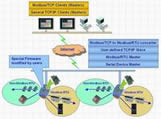 |
- Advanced application 2: Modbus/TCP controller with VxComm technique
When an £gPAC-7186PEX-MTCP links same hardware devices as Advanced application 1 link to, if any devices connected to certain COM ports are not integrated into your custom firmware, you are still able to access the COM ports via the standard serial driver. In order to do this, you must install the VxComm driver on the host PCs.
|
|
|
|
| |
|
|
|
|
|
| |
|
|
| |
|
|
| |
| CPU |
| CPU |
80186, 80MHz or compatible |
| SRAM |
512K bytes |
| Flash Memory |
512K bytes |
| EEPROM |
16K Bytes |
| NVRAM |
31 Bytes (battery backup, data valid up to 10 year) |
| RTC (Real Time Clock) |
Yes |
| 64-bit Hardware Serial Number |
Yes |
| Built-in Watchdog Timer |
Yes |
| Communication Interface |
| COM1 |
RS-232 (TXD, RXD, RTS, CTS, GND) |
| COM2 |
RS-485 (D2+, D2-) |
| Ethernet Port |
10/100Base-TX Ethernet Controller
Auto-negotiating, Auto_MDIX, LED indicator) |
| COM Port Formats |
| Data bit |
7, 8 |
| Parity |
Even, Odd, None |
| Stop bit |
1 |
| LED Display |
| 5-Digit 7 Segment LED Display |
Yes (for £gPAC-7186PEXD-MTCP only) |
| System LED Indicator |
Yes |
| Hardware Expansion |
| I/O expansion bus |
Yes |
| User defined I/O pins |
14 pins |
| Dimensions |
| W x H x D |
72 mm x 123 mm x 35 mm |
| Operating Environment |
| Operating Temperature |
-25¢XC ~ +75¢XC |
| Storage Temperature |
-40¢XC ~ +80¢XC |
| Power |
| Protection |
Power reverse polarity protection |
| Input Range |
PoE |
IEEE 802 3af, Class 1 |
| Terminal block |
+12 ~ 48 VDC (non-regulated) |
| Power consumption |
1.5 W for £gPAC-7186PEX-MTCP
2.5 W for £gPAC-7186PEXD-MTCP |
|
|
|
|
| |
|
|
|
|
|
| |
|
|
| |
|
|
| |
| £gPAC-7186PEX-MTCP CR |
£gPAC-7186PEX with default Modbus/TCP firmware (RoHS) |
| £gPAC-7186PEXD-MTCP CR |
£gPAC-7186PEXD with default Modbus/TCP firmware (RoHS) |
|
|
| |
Note1:
The Modbus firmware can only run under 512K SRAM hardware. If you need more COM ports, you can buy an X board to expand the COM port number. Usage:
Step1. Open the cover of the £gPAC-7186PEX/£gPAC-7186PEXD.
Step2. Plug the X board to the £gPAC-7186PEX/£gPAC-7186PEXD.
Step3. Close the cover. |
|
| |
|
|
|
|
|
| |
|
|
|
|